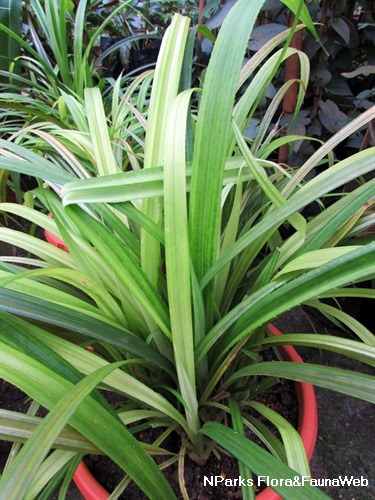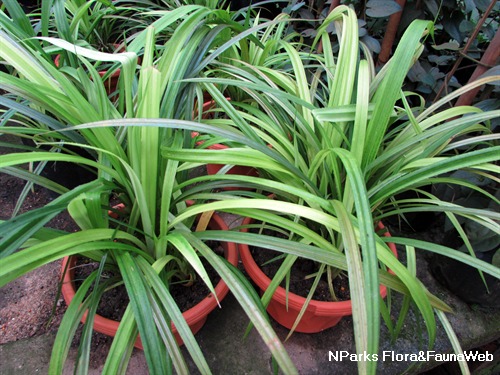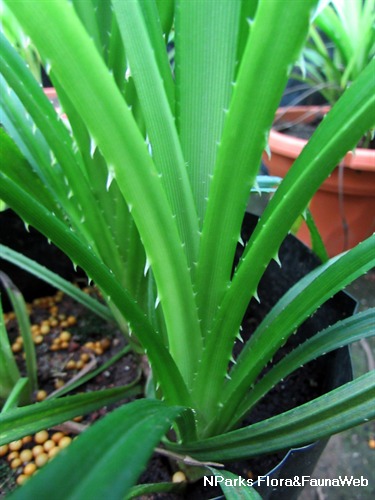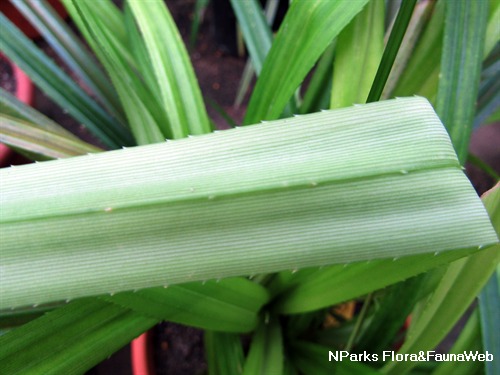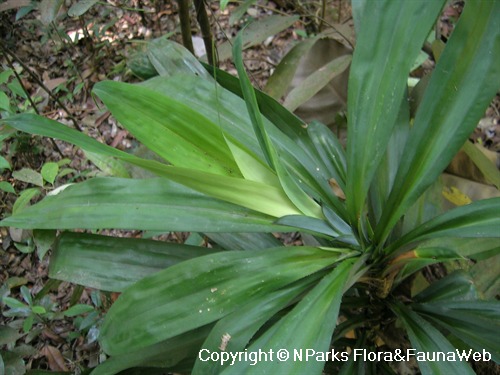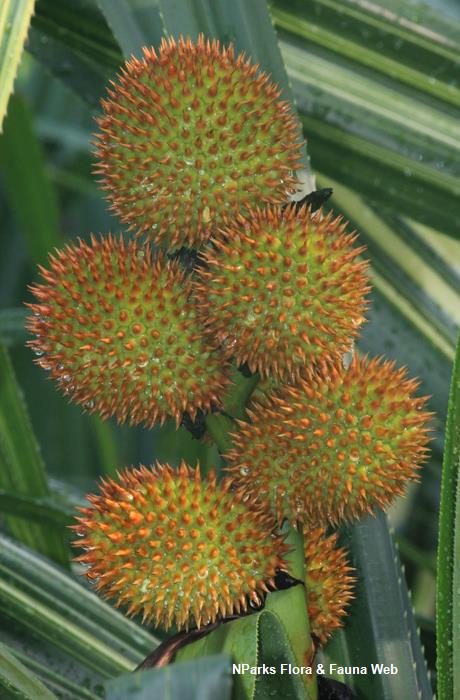
Back
Benstonea affinis (Kurz) Callm. & Buerki
| Family Name: | Pandanaceae |
| Synonyms: | Pandanus aurantiacus Ridl., Pandanus affinis Kurz |
| Common Name: | Mengkuang Bunga, Mengkuang Perah, Pandan Ikan |
Name
Classifications and Characteristics
| Plant Division | Angiosperms (Flowering Seed Plants) (Monocotyledon) |
|---|---|
| Plant Growth Form | Tree (Shrubby (1m-5m)), Shrub |
| Lifespan (in Singapore) | Perennial |
| Mode of Nutrition | Autotrophic |
| Maximum Height | 5 m |
Biogeography
| Native Distribution | Vietnam, Philippines, Malaysia, Brunei, Singapore, and Indonesia |
|---|---|
| Native Habitat | Terrestrial (Primary Rainforest, Freshwater Swamp Forest, Riverine), Shoreline (Mangrove Forest) |
| Preferred Climate Zone | Tropical |
| Local Conservation Status | Native to Singapore (Critically Endangered (CR)) |
Description and Ethnobotany
| Growth Form | It is an erect, branching shrub or small tree up to 5 m tall, with slender stems and prop roots. |
|---|---|
| Foliage | Its spirally arranged leaves have leaf blades that are elongated-lance-shaped, 1 m long, 3–4 cm wide, and with spines along the edges and the upper surface. |
| Flowers | The species is dioecious, producing either male or female flowers on different individuals. Its flowers are small, have no petals, and are found in numerous-flowered clusters. The female flowers are bright orange-red and found in clusters that are 6.4 by 2.5 cm. |
| Fruit | The fruit is fleshy with a stony core, orange-red, oblong-pyramidal, 2–2.3 cm long, and can be found in numerous-fruited heads. The fruit-heads are oblong-round and are in turn found in 3–9 fruited clusters. |
| Associated Fauna | Its flowers are insect-pollinated. |
| Cultivation | It can be propagated by seed or by division of young plants from the parent plant. |
| Etymology | The genus Benstonea is named in honour of Benjamin Clemens Stone (1933 - 1994) who was the leading authority on Pandanaceae family for several decades. |
| Ethnobotanical Uses | Others: It has medicinal properties, and is used by locals as fish bait. |
Landscaping Features
| Landscaping | It is suitable for parks, especially in waterlogged soils or at the edges of ponds or waterbodies. |
|---|---|
| Desirable Plant Features | Ornamental Flowers, Ornamental Foliage, Ornamental Fruits, Ornamental Form |
| Landscape Uses | Parks & Gardens, Riverine, Pond / Lake / River, Marsh / Bog |
| Usage Hazard - Cons | Spines/Thorns - Stem/Branch, Spines/Thorns - Leaf |
Fauna, Pollination and Dispersal
| Pollination Method(s) | Biotic (Fauna) |
|---|---|
| Seed or Spore Dispersal | Biotic (Fauna), Abiotic |
Plant Care and Propagation
| Light Preference | Full Sun, Semi-Shade |
|---|---|
| Water Preference | Lots of Water |
| Plant Growth Rate | Moderate |
| Rootzone Tolerance | Waterlogged Soils (Drains Site, Does not Drain Site) |
| Propagation Method | Seed, Division |
Foliar
| Foliage Retention | Evergreen |
|---|---|
| Mature Foliage Colour(s) | Green |
| Mature Foliage Texture(s) | Smooth |
| Foliar Type | Simple / Unifoliate |
| Foliar Arrangement Along Stem | Rosulate / Rosette |
| Foliar Attachment to Stem | Sessile |
| Foliar Shape(s) | Non-Palm Foliage (Lanceolate, Linear) |
| Foliar Venation | Parallel |
| Foliar Margin | Serrate / Toothed |
Floral (Angiosperm)
| Flower & Plant Sexuality | Unisexual Flowers , Dioecious |
| Flower Colour(s) | Orange, Red |
|---|
| Flower Grouping | Cluster / Inflorescence |
| Flower Location | Axillary |
Fruit, Seed and Spore
| Mature Fruit Colour(s) | Orange, Red |
|---|---|
| Fruit Classification | Simple Fruit |
| Fruit Type | Fleshy Fruit , Non-Accessory Fruit |
Image Repository
Others
| Master ID | 32046 |
|---|---|
| Species ID | 6451 |
| Flora Disclaimer | The information in this website has been compiled from reliable sources, such as reference works on medicinal plants. It is not a substitute for medical advice or treatment and NParks does not purport to provide any medical advice. Readers should always consult his/her physician before using or consuming a plant for medicinal purposes. |

